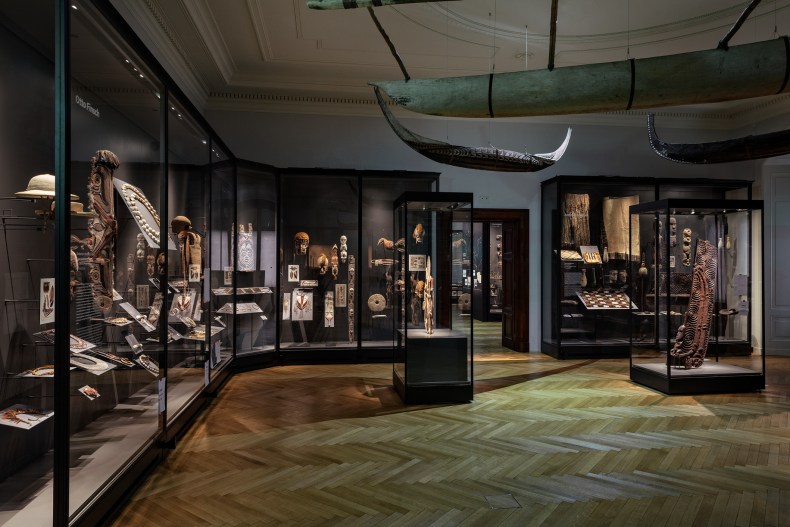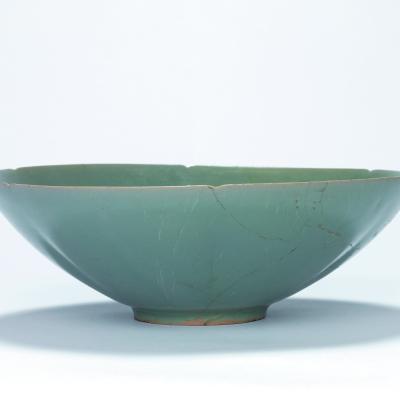‘We decided to give the best spot to the children.’ Steven Engelsman, the director of the Weltmuseum Wien (World Museum, Vienna), is talking about the institution’s education room, which until now has always been the director’s office, on the day of the museum’s reopening in late October. If you look out of the double-aspect windows, his meaning is clear. The museum, which holds the outstanding ethnographic collections of the Hapsburgs, is located in the last completed wing of the Hofburg, the former imperial palace; the room we are in now looks in one direction towards the parliament building and city hall, and in the other along the façade of the rest of the Hofburg, with a good view of the balcony from which Hitler made a speech acclaiming the annexation of Austria by Nazi Germany in March 1938.
The site, as well as the museum itself and its collection, is full of historical resonances, but there’s also a good deal of less momentous contemporary bustle surrounding the Weltmuseum’s reopening. It is 10 days after the Austrian parliamentary elections and just before the Austrian National Day. The latter marks Austria’s declaration of neutrality in 1955 after the withdrawal of the four Allied Powers, and the end of the division of Vienna. In practice this means that there are incongruous displays of military hardware within the city’s Ringstrasse – a helicopter and some tanks outside the entrance to the Volksgarten; more tanks and relaxed-looking soldiers milling around the Heldenplatz and setting up marquees, and so on. The show the Austrian army puts on is an annual affair; the recent parliamentary elections – in which immigration and Austrian nationalism were key issues – were more fraught. At the time of writing in mid November, a coalition between the centre-right Austrian People’s Party and, most likely, the far-right Freedom Party has not yet been agreed.
‘South Seas – Encounters with Paradise Lost’ gallery, displaying objects from Cook’s expeditions. © KHM-Museumsverband

The mission of the Weltmuseum, as Engelsman describes it, couldn’t be more perfectly fashioned for its site and for this time. The transformation of the former Museum of Ethnology, which was founded in 1876 and closed in 2004, into the Weltmuseum has involved many pauses and revisions along the way. As recently as 2014, the new museum’s display space was cut by nearly 15 per cent and the budget reduced by 20 per cent so it is perhaps a testament to the curatorial teams – and the quality of the museum’s collections – that the results are so impressive. The shift in approach between the late 19th-century museum and now, Engelsman explains, is the move away from ‘representing faraway peoples, from cultures all over the world, to a museum that understands itself as the keeper of 200,000 fantastic objects, that have travelled all over the world to Vienna, with all sorts of fantastic stories of why these objects have come together’. The museum is also firmly committed to the idea of Vienna as a city shaped by migration, aiming to show that ‘migration is for man what the sun and the rain is for the weather – it is a fact of life’.
If the Quai Branly in Paris sets the standard for how to display ethnographic objects beautifully, the Weltmuseum’s 14 galleries don’t seem aesthetically very far behind. Where they far surpass the Quai Branly, it seems to me, is in the quantity and quality of explanation and interpretation. There are just as many dimly lit rooms with dramatically spot-lit exhibits and intriguing juxtapositions in Vienna as in Paris, but here the display cases – even the museum’s star Aztec feather headdress, sent to Europe by Cortés – are contextualised by the circumstances of their contents’ acquisition, instead of the mysterious, perhaps embarrassed silence of Paris.
Display of Indian theatrical props collected by Franz Ferdinand (in centre of the photograph) at the Weltmuseum. Wien. Photo: © KHM-Museumsverband

The Hapsburg monarchs didn’t of course have the kind of far-flung colonial empires that Britain, France, Belgium, and then Germany set out to acquire – and perhaps this lends a greater ease to this particular ethnographic museum. While administering their European holdings, the Hapsburgs also collected – through marriage, trade and exchange – the kind of exotic objects that other powers were stockpiling through conquest, among other means. The most spectacular of these acquisitions must be the largest part of the 1806 break up of the Leverian collection, which included the auction of items from Cook’s voyages. A gallery called ‘In the Shadow of Colonialism’ sounds straightforwardly didactic, but the actual displays present the 19th-century collecting forays of the ill-fated Archdukes Maximilian (executed in Mexico), Rudolf (of the suicide pact at Mayerling), and Franz Ferdinand (assassinated in Sarajevo).
In 1892–93, Franz Ferdinand set sail for North America, via India. One of the most striking trophies from his 10-month trip is an assortment of Indian theatrical props and puppets. The pyramid of disembodied heads and figures is cleverly topped, when you look directly at the display case, by an enlarged photograph of Franz Ferdinand in a hunting group, appearing as removed from us as the items he collected. There’s also a reminder that long before the Archduke became a byword for the fall of Western civilisation, he was planning the world’s largest private museum: ‘I suffer from museomania!’ he declared. In some respects the Weltmuseum is an object lesson in unintended historical ironies.
From the December 2017 issue of Apollo: preview and subscribe here


